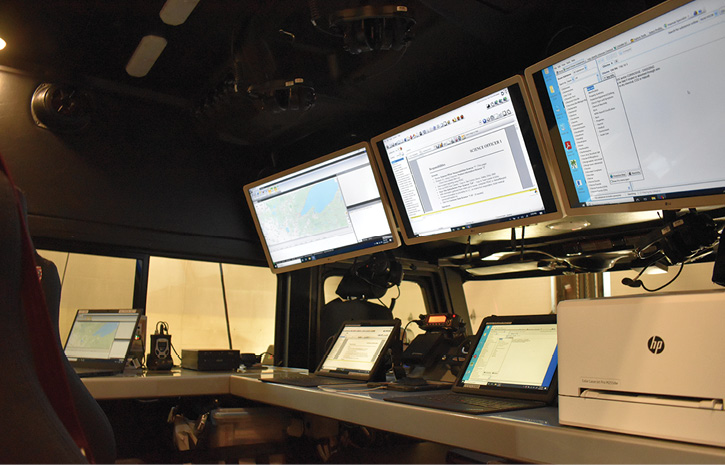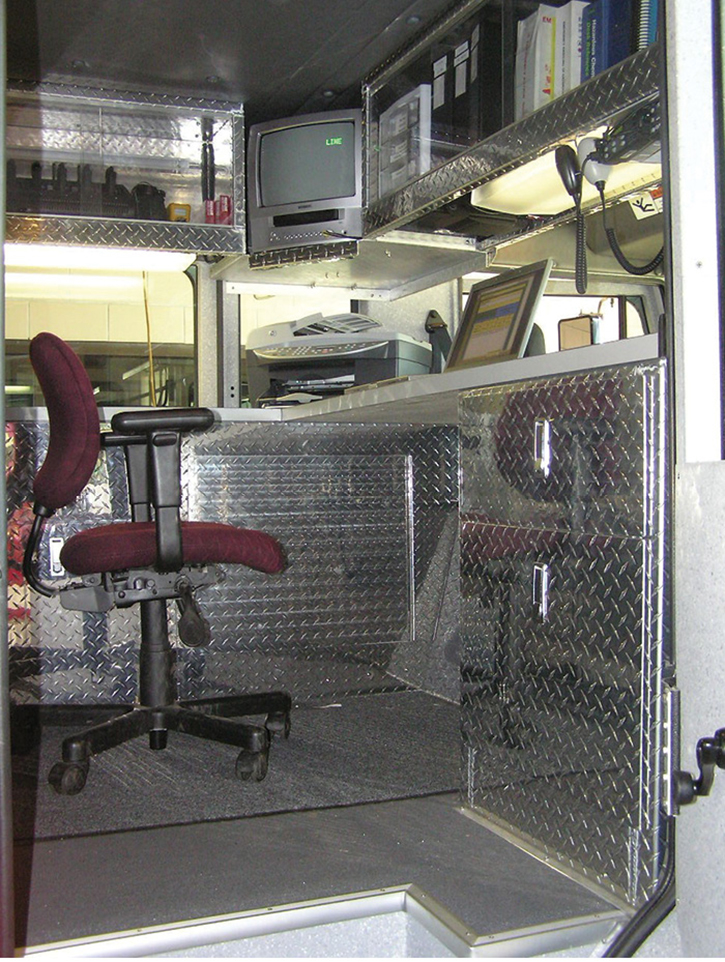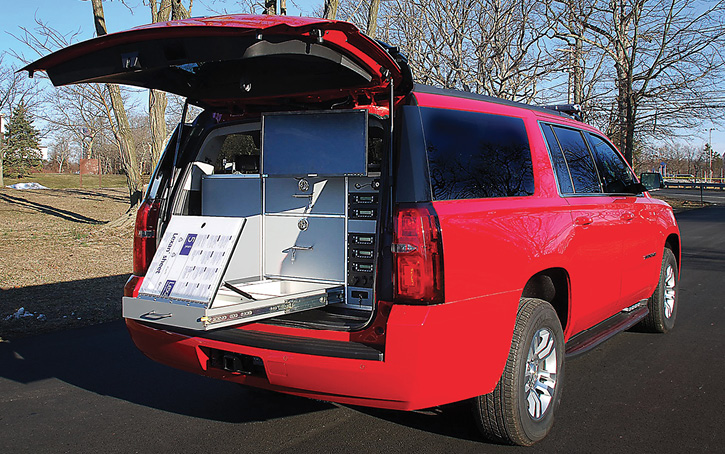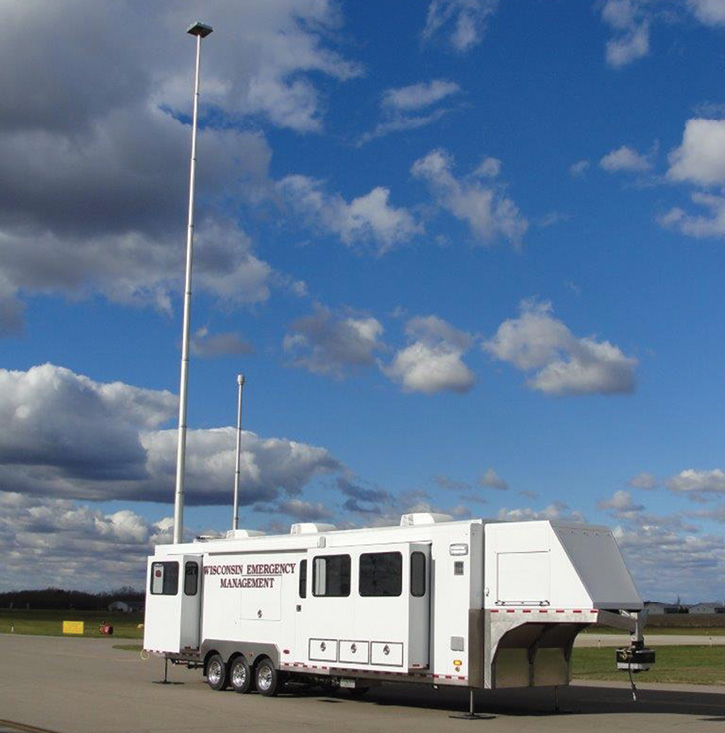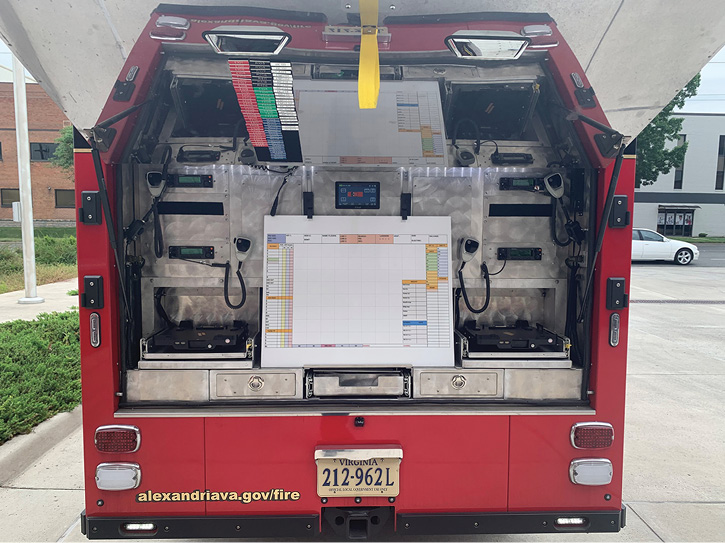At one time, command vehicles were large RV– or tour bus-sized rigs that held a large amount of communications gear, electronics, and even rehab facilities.
Such vehicles still are used by fire departments, but medium-sized and smaller command vehicles have become popular and seem to be put in the field more frequently. Let’s look at the big, medium, and small command rigs being built for fire departments.
1 Frontline Communications, a division of Pierce Manufacturing Inc., built a command unit featuring a large command center area for the San Antonio (TX) Fire Department on a Pierce Velocity custom chassis with a two-door cab, 40-foot body, and four slide-out sections. (Photo courtesy of Frontline Communications.)
2 Rosenbauer built a command center into a hazardous materials response truck for the Duluth (MN) Fire Department. (Photo courtesy of Sentinel Emergency Solutions.)
3 This compact command center was built into a heavy rescue built by Summit Fire Apparatus for the Anderson County (SC) Fire Department. (Photo courtesy of Summit Fire Apparatus.)
Steve Williamson, director of sales for Frontline Communications, a division of Pierce Manufacturing Inc., says that while his company has built some medium-sized command units, it continues to build a lot more larger command vehicles, with about three-quarters of the units it builds being the larger platforms.
“Most of the demand is for a vehicle with a 40-foot body on either a custom or a commercial chassis,” Williamson notes. “These vehicles are typically used for longer-term emergencies and also for preplanned events.”
Williamson says Frontline recently delivered a command unit to the San Antonio (TX) Fire Department built on a Pierce Velocity® custom chassis with a two-door cab, a 40-foot body, and four slide-out sections. The rig has an overall length of 44 feet 5 inches and an overall height of 13 feet 5 inches and is powered by a 525-horsepower (hp) Detroit Diesel DD13 diesel engine. “There’s a passenger side entry door midship and a rear entry door with fold-out steps,” he points out, “leading to an interior conference room designed to replicate the functionality of a physical emergency operations center (EOC).”
The San Antonio command unit has five 15,000-Btu (British Thermal Unit) rooftop-mounted air conditioning units, a 42-foot Will-Burt mast, three full-height equipment racks, two exterior monitor compartments with fold-down trays in the curb side slide-outs, a Will-Burt Powerlite tower, a 360-degree mast with a dual high-definition and thermal system, two Dish network high-definition satellite receivers, a CNC Technologies Diversity receive antenna system, an Airmar weather station, a Cisco secure LTE network, a security perimeter camera system, an AvL Technologies 1.2-meter low-stow Ku-Band VSAT antenna system, a Telex 24-line phone system, and 28 video monitors including 15 touch screens, a 65-inch Ultra HD 4K touch screen, and a 43-inch exterior anti-glare HD television.
Brian Franz, vice president of apparatus at Sentinel Emergency Solutions and a Rosenbauer representative, notes that he’s seen a change in demand from large command units to much smaller ones. “Many departments don’t have the personnel now to roll and staff giant command units, so battalion chiefs are carrying small command centers on their vehicles,” Franz observes. “We have built a number of three-door rescue trucks that incorporate command centers into the cabs, but the technology has changed so rapidly that we aren’t seeing that many of them lately. A lot of departments are putting a drone on a rescue truck that feeds data and images to an iPad on the truck, so you don’t need a 20-foot mast on a big truck anymore.”
4 Rescue 1 built this command area into the back of a Chevrolet Suburban chief’s vehicle for the Spring (TX) Fire Department. (Photo courtesy of Rescue 1.)
5 CustomFIRE built this fifth wheel trailer command unit for the Wisconsin Emergency Management Agency. (Photo courtesy of CustomFIRE.)
6 The Alexandria (VA) Fire Department had CustomFIRE build a command area into the rear custom body on a GMC 2500 pickup truck. Alexandria had four vehicles built for its four shift operations personnel. (Photo courtesy of the Alexandria Fire Department.)
Joe Messmer, president of Summit Fire Apparatus, says Summit has built a wide variety of command units for fire departments and regional emergency services agencies, from 40- to 50-foot trailers to command units built into the bodies of rescue trucks to a command area in the crew cab area of a Spartan chassis and cab. “It depends on the needs of the department,” Messmer observes. “For the Edgewood (KY) Fire Department, we built a rescue-pumper that has a tray over the engine cowling between the jump seats that slides out and spreads over the two rear-facing seats, making a desk for a command area.”
Other departments might need more space for a command area, he adds, or space for a command area that might also function as a changing area for hazardous materials personnel or a dive rescue team or even be set up to transport firefighters. “We’ve done some of those,” he says, “but typically a department will want an 8-foot-wide by 5- to 6-foot-deep room off the back of their rescue that can hold a desk, chair, computer, and other command equipment. We built three like that for Union Carbide that they send to any hazmat incident, and those command rooms have a drain in the floor so the room can be deconned after use. That’s our specialty: multipurpose customized rooms.”
Chad Newsome, national sales manager for Rescue 1, says Rescue 1 has built both large and small command units from rigs on custom and commercial chassis with rescue bodies holding command centers and conference rooms to a command unit in the back of a Suburban with the two rear seats rows removed to allow a command area for the chief.
“For the larger command units, typically there’s an entrance at the body’s midpoint and another at the rear,” Newsome notes. “With our trucks, we build extreme duty interiors, which may have less form but definitely more function in terms of ruggedness and durability.”
Ben Bregg, design engineer for Spencer Manufacturing, says Spencer also has built both large and small command units. “The larger example would be a walk-in rescue truck with a command center inside,” Bregg says, “where there would be multiple radios, a desk or work surface, and space for incident plan and research materials. Often the area is tied in with firefighter rehab and might have a bench seat and mini-fridge.”
On the smaller side of command units, Bregg says some departments are going to a command center on a slide-out tray in a chief’s pickup truck bed. “The slide-out would be set up with multiple radios, have a laptop mount, carry a gas meter, Knox box, lights, first-in bag, AED (automated external defibrillator), suctions, and self-contained breathing apparatus (SCBA), all under a topper,” Bregg notes. “They’re usually on Chevy 2500 or 3500 or Dodge or Ford chassis of similar size.”
Wayde Kirvida, sales engineer for CustomFIRE, says his company has built command units for a Chevron refinery on Peterbilt commercial chassis with rescue bodies and walk-in access to the command area and a fifth-wheel command trailer for the state of Wisconsin with two slide-outs on each side holding a command center and conference room, along with communications and camera masts to feed data inside. “We also built four small command chief’s vehicles for the Alexandria (VA) Fire Department on GMC 2500 pickup truck chassis with custom bodies,” he adds.
Michael Cross, Alexandria Fire Department assistant chief, says its four command units are run by the shift operations managers—two battalion chiefs, an EMS captain, and a safety officer. “Each vehicle has the ability for primary incident management, and they can be put together for a larger Incident Command Base, if necessary,” Cross points out. The rigs feature pull-out drawers and tool boards for the command desk and space for SCBA, turnout gear, and other equipment.
“The rear command module is 15 inches deep and designed as a two-person workstation with two radios and two command tablets so the incident manager and the command aide/accountability officer can work side-by-side,” Cross says, “protected under a flip-up door from the sun and rain. Fastlane Emergency Vehicles in Virginia fitted the electronics and light packages and added swing-out wings on the rear corners to hang command boards.”
Todd Nix, apparatus consultant for Unruh Fire, says Unruh is developing an Incident Stabilization Unit (ISU) that has a self-contained command unit. “The ISU is on a Freightliner M2 106 4×2 chassis and crew cab with a walk-through rescue body having curb side and rear doors,” Nix says. “The front portion of the interior is a command area with a desktop, space for two computers, whiteboards, electrical connections for main power and USB ports, and cabinetry for books and literature. There’s also a bench seat for firefighter rehab, and the back portion of the interior can store SCBA, dry suits, and hazmat monitors. The rig also has the ability to take a skid to make it a wet rescue.”
ALAN M. PETRILLO is a Tucson, Arizona-based journalist, the author of three novels and five nonfiction books, and a member of the Fire Apparatus & Emergency Equipment Editorial Advisory Board. He served 22 years with the Verdoy (NY) Fire Department, including in the position of chief.

